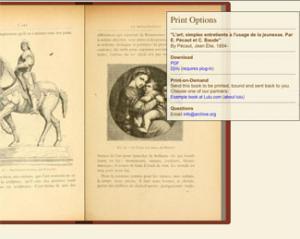
Image adapted from Open Library
This course is no longer taught at the U-M School of Information. These materials are from an older iteration of the course.
This is a special topics seminar focusing on the current state of “digital libraries” broadly defined. The seminar is multi-disciplinary in focus and in method, covering the history of the idea, its manifestation as projects and programs in academic, non-profit, and research settings, and the suite of policy issues that influence their development and growth. The concept of the digital library will serve as an intellectual construct within which to explore the related concepts of scholarly communication, digital preservation, cyberinfrastructure, representation, and information technology standards. Given the seminar format, students will be expected to master a diverse literature, to participate actively in the discussion of issues, and to take steps, collectively and individually, to advance our understanding of future directions of digital libraries.
Instructor: Paul Conway
dScribe: Greg Grossmeier
Course Level: Graduate
Course Structure: Three hour class - once a week
Syllabus
Description
This is a special topics seminar focusing on the current state of “digital libraries” broadly defined. The seminar is multi-disciplinary in focus and in method, covering the history of the idea, its manifestation as projects and programs in academic, non-profit, and research settings, and the suite of policy issues that influence their development and growth. The concept of the digital library will serve as an intellectual construct within which to explore the related concepts of scholarly communication, digital preservation, cyberinfrastructure, representation, and information technology standards. Given the seminar format, students will be expected to master a diverse literature, to participate actively in the discussion of issues, and to take steps, collectively and individually, to advance our understanding of future directions of digital libraries.
Objectives
- Understand the history and development of digital libraries as an international phenomenon
- Explore the literature, key players, and significant digital library programs
- Specify the critical skills required to build and maintain digital libraries
- Define a set of research questions associated with knowledge representation in digital libraries
- Establish a broad context issues and challenges facing digital libraries
Readings
Required readings average 150 to 250 pages per week, with optional reading determined by each student’s interests and knowledge, as well as the relevance of a given topic to course projects and final reports. All required readings are either on the World Wide Web (WWW), accessible through the CTools site for the course, or available through University Reserves’ Electronic Reserve Service. http://www.lib.umich.edu/reserves
Resources
Weekly lecture slides, additional resources for class assignments and weekly discussion topics will be posted on CTools by start of class. Students wishing to follow the lecture with the slides can download them from CTools. The CTools Portal URL is: http://ctools.umich.edu
Assignments and Deadlines
SI 615 - DIGITAL LIBRARIES, WINTER 2008
Class Participation (25%)
The overall success of the seminar depends on the active participation of all members of the class. Class participation is a sizable portion of the grade. Students should attend all classes and be prepared to enter into class discussions and to raise questions reflecting their reading and interests. Students are also expected to complete all required readings in advance of class. This is especially important since a portion of the class sessions will be discussions about the readings.
On the first class, each student will sign up with two other students to lead the discussion on the required readings for a given week. This is an opportunity to read one set of assigned readings more deeply than average, to work collaboratively on identifying themes or critical ideas, and to demonstrate understanding of one component of the course.
Literature Scan (15%)
The purpose of the individual project is to explore and find some interesting published literature on digital libraries and report on experiencing three important research resources.
Use the search and browse tools of three resource collections on a particular topic of your choosing.
Identify ten items of relevance to the topic (at least two from each source) from ACM Digital library. ACM Digital Library http://portal.acm.org/ [access via UM Library Search Tools]; D-Lib Magazine http://www.dlib.org/; and Ariadne Magazine http://www.ariadne.ac.uk/.
Prepare full and consistent bibliographic citations for all ten items (using MLA, Chicago, or other appropriate format).
Write between one- (1) and five- (5) sentence description/summary of each source.
Write up to 1,000 words that states the topic of your search, describes the scope of the resources available on digital libraries, assesses their strength and weaknesses for digital library research, and reports on your experience using the resources,.
Image Representation Database (25%)
The purpose of this project is to explore the various ways that photographic images are represented through digital library interfaces and to become adept at recognizing such variation. A secondary purpose of the project is to begin compiling a reference and research collection of digitized images that illustrates representation variation systematically. The mechanism we will use to complete the project is the collaborative construction of a database of image elements following a fairly complex scheme. The scheme captures descriptive information about each image, codes each image for its representation style, annotates the image in ways that connect the visual product with its associated metadata, and codes the image for the “significant properties” that it displays (or contains).
Each student will be responsible for identifying and coding data in the database for a minimum of 100 images. Half of the images will be chosen from collections in one of ten possible large scale digital libraries [a list will be distributed in class]. Half of the images may be chosen from any online collection of digitized photographs anywhere in the world, as long as certain criteria are met relating to the scale of the undertaking and the organizational source of the images. Prior to the start of the project, the instructor will provide definitions of key terms, illustrative examples of various representation styles, and detailed coding instructions for building the database. The results of the exercise will be presented in class.
Grading will be based on quantitative and qualitative assessments. Quantitative scores will be assigned based on the number of images completed and the completeness of the data compiled. A qualitative score will be assigned based on the level of judgment exercised in coding representation style and other subjective elements of the combined database.
Final Report (35%)
The final report for the seminar is an opportunity to take a close look at a particular aspect of a digital library program or service and to describe that aspect in the larger context of published and informally posted information on the digital library. The paper will be between 3,000 and 5,000 words in length, will be properly documented with references and a bibliography, and will conform to a common structure. The point of departure for the paper is a close examination of one feature of a digital library from a group of large and diverse digital libraries. A list will be distributed in class after the second week. Each student will choose one digital library to examine. All of the students who choose a particular digital library will constitute one or more teams varying in size from 3 to 6 individuals. You are encouraged to work together as a team on your analysis. The team is required to prepare a single document listing published and unpublished documentation on the digital library.
Students will negotiate within their respective teams over the choice of a particular topic to investigate in greater detail. Topics relevant to this investigation include the following areas:
Content domains, accession or selection criteria
Digitization guidelines or collection development focus
Metadata standards, processes, and products
End user interface design, usability assessment, revision history
End-user productivity tool development, including search tools, display tools, edit tools, etc.
Underlying repository infrastructure, including software architecture, database design, etc.
Collaboration with other institutions at the level of process, practice, standards, data sharing, etc.
Repository/archive development, including perspectives on digital preservation versus digital access
Staffing, cost analysis, benefit analysis, and other economic/budgetary issues.
The following issue is out of scope for this review: Copyright and intellectual property
Depending upon the size and individual interests of the group, the final report may parse the project in any number of ways. The final report must include at least the following five components:
Executive summary with critical findings (1 to 2 paragraphs)
Description of the origins, history, and purposes of the digital library (may be done collaboratively by the team for all reports from that team)
Report on the issue investigation, with the following components
Definition of the issue
Assessment of state of the art for the issue
How the issue is represented in the digital library
Reconciling state of the art with reality
Trends and directions for the issue either in the digital library or more broadly
Challenges you faced in your investigation (e.g., lack of documentation, outdated interface, etc.)
In pursuing your research, you may use any published or posted information available on the digital library and you may interview or correspond with appropriate staff who may have information to share. I encourage this strategy.
Deadlines and Due Dates
January 7 — First Class
January 21 — No Class Today
January 28, 5:00 pm — Literature Scan Due
February 4, 5:00 pm — Individual DL Review Topics Due
February 11 — Form Digital Library Review Teams
February 22, 5:00 pm — Digital Library Review Bibliography Due
February 28 — Spring Break
March 14, 5:00 pm — Working outline of final report Due, if advice desired from instructor
March 21, 5:00 pm — Image Representation Database Entries Complete
April 7 — Final Report Presentations (clustered by investigation topic)
April 14 — Final Report Presentations (clustered by investigation topic)
April 18, 5:00 pm — Final Reports Due
Grading
- Class participation: 25%
- Literature scan: 15%
- Image representation project: 25%
- Research report: 35%
Learning Objectives
Objectives
- Understand the history and development of digital libraries as an international phenomenon
- Explore the literature, key players, and significant digital library programs
- Specify the critical skills required to build and maintain digital libraries
- Define a set of research questions associated with knowledge representation in digital libraries
- Establish a broad context issues and challenges facing digital libraries
Schedule
SI 615 - DIGITAL LIBRARIES, WINTER 2008
Week 1 (January 7): Introduction and Overview of Themes
In this session we will explore perspectives on the idea of a library, digital or otherwise, and collaborate to establish a shared definition of a digital library. The session will review the structure of the courses and outline its principal underlying themes. Finally, this session cover the major sources of information on digital libraries.
Week 2 (January 14): History and International Perspectives
Digital libraries have a distinctive history, a consideration of which sheds light on the predispositions of those who design and build them. This session will contrast design/build perspectives on an international basis with what we do and do not know about the people who use them.
Week 3 (January 21): Martin Luther King Day – No Class
Week 4 (January 28): Content Landscapes: How Much Information
In spite of the fact that the manufacture of paper continues unabated, we are living in a digital world. This session will explore alternative scenarios for describing the landscape of digital content, using as a point of departure a seminal study that attempts to measure the volume of information.
Week 5 (February 4): Research Agendas
Sometimes it’s useful to make lists. Research agendas for digital libraries, digital preservation capabilities, and the management of electronic records provide insight into the shifting perspectives on needs and requirements. This session will explore at least a decade’s worth of research agendas against our emerging understanding of what digital libraries are.
Week 6 (February 11): Interface and Metadata Infrastructure
What you see isn’t necessarily what you get. This session will explore the distinction between the user interface and the underlying structure of information used to describe, structure, and administer a digital archive or repository. We will work with several XML models of digital library metadata infrastructure and explore the elements of interface design that enable or constrain use.
Week 7 (February 18): Representation of Image/Text and Visual Digital Libraries
This session will look closely at several models of how humanities text and image resources are represented in digital form. A project on diagnosing and detecting image representation will be introduced.
Week 8 (March 3): Cyberinfrastructure
This session will introduce the concept of “cyberinfrastructure” and explore the technical and policy issues associated with science, social science, and humanities data and users.
Week 9 (March 10): Scholarly Communication and Digital Library Use
Models of scholarly communication (which vary somewhat by discipline) provide a framework for exploring access and use issues in digital libraries. This and next week’s sessions together will force us to confront the ongoing tensions between the idealization of digital libraries and the barriers presented by the technical, organizational, and policy constraints.
Week 10 (March 17): Institutional Repositories and Preservation
This session will look closely at emerging models of institutional repositories, their relationship to emerging preservation requirements, including data modeling and trust systems.
Week 11 (March 24): Case Study of UM Deep Blue and Blue Stream
This session takes a close look at two technologies at the University of Michigan that support the university’s digital repository efforts, including the ingest and processing of digital multi-media resources. The case study explores the extent to which multiple technologies are and are not yet integrated from the perspective of infrastructure and interface.
Week 12 (March 31): Sustaining Digital Libraries
Sustainability could turn out to be one of the principal challenges of digital libraries (an open question). This final session will explore a variety of incentive mechanisms associated with the design of digital libraries and their use.
Week 13 (April 7): Wrap-up and Research Paper Reports
This and the final session will provide opportunities for synthesis across seminar topics, taking as a point of departure the issues explored in student research papers. Each project will be allotted be allocated roughly five minutes for a succinct presentation on the core concept and key findings of the project. The quality of the presentation, measured in terms of clarity of communication, will be count for roughly 25% of the project grade.
Week 14 (April 14): Wrap-up and Research Paper Reports
Reading List
Week 1: Introduction and Overview of Themes
Required Readings:
Borgman. [2000] Gutenberg to Global Information Infrastructure, Chapter 2, pp. 33-52.
Levy. [2003] “Documents and Libraries, in Bishop, et al. Digital Library Use, Chapter 2, pp. 25-42.
Resources:
Fox, & Urs. [2002] “Digital Libraries.” Annual Review of Information Science and Technology 36. Information Today, Inc.
Bearman. [2007] “Digital Libraries.” Annual Review of Information Science and Technology 41. Information Today, Inc.
Week 2: History and International Perspectives
Required Readings:
Dempsey. [2006] “The (Digital) Library Environment: Ten Years After.” http://www.ariadne.ac.uk/issue46/dempsey/
Stephenson. [1996] “Mother Earth Mother Board.” http://www.wired.com/wired/archive/4.12/ffglass.html?topic=&topic_set=
Woldering. [2004] “The European Library: Integrated Access to the National Libraries of Europe.”http://www.ariadne.ac.uk/issue38/woldering/
Resources:
Fox. [1993] Digital Library Sourcebook. http://fox.cs.vt.edu/DLSB.html
Digital Library Federation. http://www.diglib.org/
ERPANET: European Resource Preservation and Access Network. http://www.erpanet.org/index.php
JISC: Joint Information Systems Committee. http://www.jisc.ac.uk/
PADI: Preserving Access to Digital Information. http://www.nla.gov.au/padi/
Week 3: Martin Luther King Day – No Class
Week 4: Content Landscapes: How Much Information
Required Readings:
Lyman and Varian. [2003] How much information? 2003. http://www2.sims.berkeley.edu/research/projects/how-much-info-2003/
OCLC. [2004] “2004 Information Format Trends: Content, Not Containers,”http://www.oclc.org/reports/2004format.htm
O’Toole. [1994] “On the Idea of Uniqueness.”
Powell. [2003] “Mapping the JISC IE [Information Environment] Service Landscape.”http://www.ariadne.ac.uk/issue36/powell/intro-alternative.html
Resources:
Digital Library Federation. Registry of Digital Masters. http://www.diglib.org/collections/reg/reg.htm
Digital Library Federation. DLF Aquifer. http://www.diglib.org/aquifer/
JISC Collections: delivering resources online. http://www.jisc-collections.ac.uk/
Week 5: Research Agendas
Required Readings:
Anderson and Choudhury. [2003] “A Usability Research Agenda for Digital Libraries.”
http://dkc.jhu.edu/usability_1.html
Hedstrom. [2003] It’s About Time: Research Challenges in Digital Archiving and Long-Term Preservation. [Attached]
Hedstrom. [2002] “The Digital Preservation Research Agenda.” http://www.clir.org/pubs/abstract/pub107abst.html
Levy. [1998] “Heroic Measures.” http://www.acm.org/pubs/citations/proceedings/dl/276675/p152-levy/
Lynch and Garcia-Molina. [1995] "Interoperability, Scaling, and the Digital Libraries Research Agenda." http://www-diglib.stanford.edu/diglib/pub/reports/iita-dlw/main.html
Waters and Garrett. [1996] Preserving Digital Information. http://www.rlg.org/ArchTF/
Resources:
UM Collaboratory Working Groups. http://www.si.umich.edu/UMDL/EU_Grant/home.htm
EU-NSF Working Group on Metadata. Metadata for Digital Libraries: a Research Agenda.http://www.ercim.org/publication/ws-proceedings/EU-NSF/metadata.html
National Science Foundation. Digital Libraries Initiative, Phases One and II. http://www.dli2.nsf.gov/http://www.dli2.nsf.gov/dlione/
Week 6: Interface and Metadata Infrastructure
Required Readings:
Borgman. [2000] “Making Digital Libraries Easier to Use,” pp. 143-163.
Campbell. [2000] “The Case for Creating a Scholars Portal to the Web.” http://www.arl.org/newsltr/211/portal.html
Caplan and Guenther. [2005] “Practical Preservation: the PREMIS Experience.”http://www.loc.gov/standards/premis/caplan_guenther-librarytrends.pdf
Dahlquist, et al. [2005] “Integrating Digital Libraries and Electronic Publishing in the DART Project.”http://doi.acm.org/10.1145/1065385.1065411
Lavoie. [2004] Open Archival Information System: Introductory Guide.http://www.dpconline.org/graphics/reports/index.html
Lynch. [2000] "Authenticity and Integrity in the Digital Environment."http://www.clir.org/pubs/reports/pub92/lynch.html
McDonough [2006] “METS”
Resources:
National Digital Information Infrastructure Preservation Program. http://www.digitalpreservation.gov/index.html
Flecker. [2000] “Harvard’s Library Digital Initiative: Building a First Generation Digital Library Infrastructure.” D-Lib Magazine 6 (November 2000). http://www.dlib.org/dlib/november00/flecker/11flecker.html
Higgins and Semple. [2006] OAIS Five-year Review. http://www.dcc.ac.uk/events/oais-fyr-2006/.
PREMIS: Preservation Metadata Maintenance Activity. http://www.loc.gov/standards/premis/
METS: Metadata Encoding and Transmission Standard. http://www.loc.gov/standards/mets/
Week 7: Representation of Image/ Text in Visual Digital Libraries
Required Readings:
Barney et al. [2005] “Ordering Chaos” doi:10.1093/llc/fqi002 [access through Mirlyn]
Bolter & Grusin. [1996] "Remediation." http://muse.jhu.edu/journals/configurations/v004/4.3bolter.html
Sassoon. [1998] “Photographic Meaning in the Age of Digital Reproduction.”http://www.sl.nsw.gov.au/lasie/prepdf.htm
Smith. [2001] Strategies for Building Digitized Collections. http://www.clir.org/pubs/abstract/pub101abst.html
Summit on Digital Tools for the Humanities. [2003] http://www.iath.virginia.edu/dtsummit/
Resources:
National Archives and Records Administration. [2004] NARA Guidelines for Digitizing Archival Materials for Electronic Access. http://www.archives.gov/research/arc/digitizing-archival-materials.html
Handout on digital imaging guidelines [on CTools]
Selected Readings: Archival Perspectives
Kaplan, Elisabeth, “Many Paths to Partial Truths: Archives, Anthropology, and the Power of Representation,” Archival Science 2 (2002): 209-20.
p. 211: [Archivists] “ … actually serve as intermediaries between a subject and its later interpreters, a function/role that is one of interpretation itself. That translates into power over the record and how it is interpreted; and it points to where power is negotiated and exercised. This power over the evidence of representation, and the power over access to it, endows us with some measure of power over history, memory, and the past.”
Yakel, Elizabeth, “Archival Representation,” Archival Science 3 (2003): 1-25.
p. 25: “Archival representation processes are neither objective nor transparent. As such, archivists need to be more conscious of the activities that structure the creation of representations, their social construction, as well as their appropriate uses. Archival representations speak not only about the collections for which they act as surrogates, but also about archival practice and archivists.”
Yeo, Geoffrey, “Concepts of Record (1): Evidence, Information, and Persistent Representations,” American Archivist 70 (Fall/Winter 2007): 315-343.
p. 337: “To differentiate records from other kinds of representation, records can be characterized as persistent representations of activities, created by participants or observers of those activities or by their authorized proxies.” 3 attributes: records have persistence; records are representations of activities; records are created by persons or devices (participants, observers, proxies).
Selected Readings: Disciplinary and Interdisciplinary Perspectives
Abukhanfusa, Kerstin (ed.). The Concept of Record: Second Stockholm Conference on Archival Science and the Concept of Record, 30-31 May 1996. Stockholm: Riksarkivet, 1998.
Ankersmit, F. R. Historical Representation. Stanford: Stanford University Press, 2001. [history]
Clapin, Hugh, “Tacit Representation in Functional Architecture,” in Philosophy of Mental Representation, ed. Hugh Clapin. Oxford: Clarendon Press, 2002. P. 309: “Representational schemes carry significant tacit semantic baggage [which] means that every translation or recoding from one scheme to another must add to or change that tacit content.”
Clarke, Bruce and Linda Dalrymple Henderson, eds., From Energy to Information: Representation in Science and Technology, Art, and Literature. Stanford: Stanford University Press, 2002.
Cummins, Robert, Representations, Targets, and Attitudes. Cambridge: MIT Press, 1996. [philosophy]
Dyer, Richard. The Matter of Images: Essays on Representation, 2nd ed. London: Routledge, 2002. P. 3 “Because one can see reality only through representation, it does not follow that one does not see reality at all. Partial, selective vision of something is not no vision of it whatsoever.”
Gibson, James J., The Ecological Approach to Visual Perception. New York: Houghton Mifflin, 1979. Originated the notion of “affordances” as properties and functions provided by a resource.
Mitchell, W. J. T. “Representation,” in Critical Terms for Literary Study, ed. Frank Lentricchia and Thomas McLaughlin. Chicago: University of Chicago Press, 1990.
Nichols, Bill, Representing Reality. Bloomington: Indiana University Press 1991. [photography]
Stampe, Dennis W. “Toward a Causal Theory of Linguistic Representation,” Midwest Studies in Philosophy 2 (1977): 48, 50-1.
Week 8: Cyberinfrastructure
Required Readings:
American Council of Learned Societies. [2006] Our Cultural Commonwealth.http://www.acls.org/cyberinfrastructure/cyber.htm
Arms et al. [2006] “A Research Library Based on the Historical Collections of the Internet Archive.”http://www.dlib.org/dlib/february06/arms/02arms.html
Association of Research Libraries. [2006] “Long-term Stewardship of Digital Data Sets in Science and Engineering.”http://www.arl.org/info/frn/other/ottoc.html
Berman and Brady [2005] “Final Report: NSF SBE-CISE Workshop on Cyberinfrastructure and the Social Sciences,” http://vis.sdsc.edu/sbe/
Messerschmit. [2003] “Opportunities for Research Libraries in the NSF Cyberinfrastructure Program,”http://www.arl.org/newsltr/229/cyber.html
National Science Foundation. [2003] Revolutionizing Science and Engineering Through Cyberinfrastructure.http://www.nsf.gov/od/oci/reports/toc.jsp
NSF Cyberinfrastructure Council. [2006] NSF’s Cyberinfrastructure Vision for 21st Century Discovery.http://www.nsf.gov/od/oci/ci-v7.pdf
Resources:
National Science Foundation. Cyberinfrastructure Office. Reports and Workshops Relating to Cyberinfrastructure and Its Impacts. http://www.nsf.gov/od/oci/reports.jsp
Data Document Initiative. http://www.ddialliance.org/index.html
Economic and Social Data Services. [2005] Guide to Good Practice: Data Management.http://www.esds.ac.uk/support/guides/A4.pdf
Lord and Macdonald. [2003] e-Science Curation Report. http://www.jisc.ac.uk/uploaded_documents/e-ScienceReportFinal.pdf
Week 9: Scholarly Communication and Digital Library Use
Required Readings:
Borgman. [2003] “Designing Digital Libraries for Usability,” pp. 117-168.
Campbell. “The Case for Creating a Scholars Portal to the Web.” http://www.arl.org/newsltr/211/portal.html
Farb. [2006] “Libraries, licensing and the challenge of stewardship.”http://www.firstmonday.org/issues/issue11_7/farb/index.html
Levy. [1998] “Heroic Measures.” http://www.acm.org/pubs/citations/proceedings/dl/276675/p152-levy/
Rusbridge. [2005] “Information Life Cycle and Curation.” Powerpoint. [Attached]
Waters. [2006] “Managing Digital Assets in Higher Education.” http://www.arl.org/newsltr/244/assets.html
Resources:
First Monday. [2006] Openness: Code, Science, and Content. Website.http://www.firstmonday.org/issues/issue11_7/index.html
Association of Research Libraries. New Models for Scholarly Communication. Website.http://www.arl.org/osc/models/index.html
Create Change. Website. http://www.createchange.org/
Week 10: Institutional Repositories and Preservation
Required Readings:
Crow. [2002] "The Case for Institutional Repositories: A SPARC Position Paper." http://www.arl.org/sparc/IR/ir.html.
Green and Gutmann. [2006] “Building Partnerships Among Social Science Researchers, Institution-based Repositories and Domain Specific Data Archives.” [preprint]
Lagoze, et al. [2006] “Fedora”
Lavoie and Dempsey. [2004] “Thirteen Ways of Looking at…Digital Preservation.”http://www.dlib.org/dlib/july04/lavoie/07lavoie.html
Lynch and Lippincott. [2005] “Institutional Repository Deployment in the United States as of Early 2005.”http://www.dlib.org/dlib/september05/lynch/09lynch.html
Keller, Reich, and Herkovic. [2003] “What is a library anymore, anyway?”http://www.firstmonday.org/issues/issue8_5/keller/index.html
Rusbridge. [2006] “Excuse Me… Some Digital Preservation Fallacies?” http://www.ariadne.ac.uk/issue46/rusbridge/
Rusbridge et al. [2005] “The Digital Curation Centre: A Vision for Digital Curation.” [Attached]
Resources:
Lee, et al. [2002] “The State of the Art and Practice in Digital Preservation.”http://nvl.nist.gov/pub/nistpubs/jres/107/1/cnt107-1.htm
Lynch. [2003] "Institutional Repositories: Essential Infrastructure for Scholarship in the Digital Age."http://www.arl.org/newsltr/226/ir.html .
NEDCC. [2007] “Digital Preservation Readiness Webliography.”http://www.nedcc.org/resources/leaflets/6Reformatting/08DigitalPreservat...
Research Libraries Group. Digital Repository Certification. Web Page. http://www.rlg.org/en/page.php?Page_ID=580
Research Libraries Group and National Archives and Records Administration. “Audit Checklist for Certifying Digital Repositories.” http://www.rlg.org/en/page.php?Page_ID=20769
Week 11: Case Study of UM Deep Blue and Blue Stream
Required Readings:
Readings list distributed during week 8
Week 12: Sustaining Digital Libraries
Required Readings:
Digital Curation Center. http://www.dcc.ac.uk/index
Lynch. [2005] “Where Do We Go from Here? The Next Decade in Digital Libraries.”http://www.dlib.org/dlib/july05/lynch/07lynch.html
Lagoze. [2005] “What Is a Digital Library Anymore, Anyway? Beyond Search and Access in the NSDL.”http://www.dlib.org/dlib/november05/lagoze/11lagoze.html
Research Libraries Group. [2002] Trusted Digital Repositories.
http://www.rlg.org/legacy/longterm/repositories.pdf
Wheatley. [2004] Institutional Repositories in the Context of Digital Preservation.http://www.dpconline.org/graphics/reports/index.html
Resources:
TRAC: Trustworthy Repositories Audit & Certification: Criteria and Checklist. http://www.crl.edu/content.asp?l1=13&l2=58&l3=162&l4=91
DRAMBORA: Digital Repository Audit Method Based on Risk Assessment. http://www.repositoryaudit.eu/
NESTOR: Network of Expertise in Digital Long-term Preservation (Germany)http://www.langzeitarchivierung.de/index.php?newlang=eng
About the Creators

About Paul Conway
Paul Conway is an associate professor in the School of Information. His research interests include the challenges of representing and interpreting audio, visual and textual resources in digital form, extracting knowledge from large-scale image databases, and modeling the use of archives in interdisciplinary scholarship in the humanities. Conway has extensive teaching and administrative experience in the archives and preservation professions. Before joining the Michigan faculty in 2006, he held administrative positions at Duke University, Yale University, the National Archives and Records Administration, and the Society of American Archivists. He began his career as an archivist at the Gerald R. Ford Library on the U-M North Campus. Conway has made major contributions over the past 30 years to the literature on archival users and use, preservation management, and digital imaging technologies. In 2005, Conway received the American Library Association's Paul Banks and Carolyn Harris Preservation Award for his contributions to the preservation field. He currently serves on the Editorial Board of American Archivist and is a Fellow of the Society of American Archivists. more...
- Ph.D. in information and library studies, University of Michigan
- MA in history and administration of archives, University of Michigan
- BA in history, Indiana University

Image adapted from Open Library
Jump to:
| Document Title | Creator | Downloads | License |
|---|---|---|---|
|
Syllabus |
Paul Conway
|
| Document Title | Creator | Downloads | License |
|---|---|---|---|
|
Reading List |
Paul Conway
|
| Document Title | Creator | Downloads | License |
|---|---|---|---|
|
Week 02: History and International Perspectives |
Paul Conway
|
||
|
Week 04: Content Landscapes |
Paul Conway
|
||
|
Week 05: Research Agendas |
Paul Conway
|
||
|
Week 06: Interface and Infrastructure |
Paul Conway
|
||
|
Week 07: Representation of Text and Image in the Humanities |
Paul Conway
|
||
|
Week 08: Cyberinfrastructure |
Paul Conway
|
||
|
Week 10: Institutional Repositories and Preservation |
Paul Conway
|
||
|
Week 12: Sustaining Digital Libraries |
Paul Conway
|
| Document Title | Creator | Downloads | License |
|---|---|---|---|
|
Week 7, Selected Readings |
Paul Conway
|

Image adapted from Open Library
Jump to:
| Document Title | Creator | Downloads | License |
|---|---|---|---|
|
Reading List |
Paul Conway
|
||
|
Syllabus |
Paul Conway
|
| Document Title | Creator | Downloads | License |
|---|---|---|---|
|
Week 02: History and International Perspectives |
Paul Conway
|
| Document Title | Creator | Downloads | License |
|---|---|---|---|
|
Week 04: Content Landscapes |
Paul Conway
|
| Document Title | Creator | Downloads | License |
|---|---|---|---|
|
Week 05: Research Agendas |
Paul Conway
|
| Document Title | Creator | Downloads | License |
|---|---|---|---|
|
Week 07: Representation of Text and Image in the Humanities |
Paul Conway
|
| Document Title | Creator | Downloads | License |
|---|---|---|---|
|
Week 08: Cyberinfrastructure |
Paul Conway
|
| Document Title | Creator | Downloads | License |
|---|---|---|---|
|
Week 10: Institutional Repositories and Preservation |
Paul Conway
|
| Document Title | Creator | Downloads | License |
|---|---|---|---|
|
Week 12: Sustaining Digital Libraries |
Paul Conway
|



